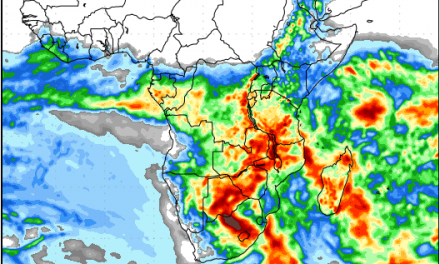
Understanding Weather Not Predicting – 3 May 2012
What happened?
That the climate has changed is beyond question. It deserves consideration regarding both the extent and impact were we are concerned.
The world’s weather continues to record events ranging from the unusual to the historically unknown, providing almost daily evidence of the shifting wind patterns, the resultant changes in the synoptics as well as in the more prolonged products, rainfall and temperature.
For instance, in theory the sea surface temperatures in the tropical Pacific are back to neutral indicating the end of the La Nina phase. The so-called southern oscillation, i.e. the difference in barometric pressure between Darwin and Tahiti, has collapsed. But the strong trade winds and the very pronounced airflow from the poles to the sub-tropical regions in both hemispheres, are indicative of a lingering La Nina.
Synoptic charts, world-wide, feature this persistent La Nina-type pattern of poleward to equator flows returning rapidly to flow poleward again. This provides airflows of depth to generate weather’s extreme ranges across broad latitudes.
These conditions are beyond record, hence totally unexpected. The controls of such airflows are reflected in the equally unusual departures from the documented ranges of the upper airflows governing the world’s climates. From our practical weather experience, rain records top the list, but temperature variation from normal have also become manifest as was witnessed last year by a particularly long and harsh winter.
Our climate is written up as Arid. Variability or the departure from the “average” is just as likely as any level within the ranges on record; yet for us the recent records (some 5 rainfall years at least) have not only tested the upper levels or even bettered them but have also seen an impressive recurrence of these upward measures.
To even the most conservative viewpoint this is a departure from normal. When coupled with the recurrent anomalies where global detail is, even hourly, on record, the impact of these departures from given norm becomes even clearer.
What’s coming?
The Southern Ocean features higher latitude anticyclonic cores and their resultant ability to form deep, intense vortex cores. Coupled to this are the frequent ridges extending into polar latitudes so maintaining the cold thrust driving the cold fronts and their rapid movement, thus governing the hemispheres’ overall pattern.
The cold front currently passing the Cape is away from the continent by weekend while a new cut-off vortex emerges in the mid-Atlantic, north of Gough Island, then tracks to the southeast to pass the Cape early next week.
With all this distant activity, all but our most southerly parts remain in a dual pattern with the area north of Otjiwarongo in an easterly flow while the middle section, south to Keetmanshoop, can expect generally light breezes from a predominantly northerly direction. Brief interruptions from elsewhere survive for barely 12 hours according to the forecasts, with the portent that, for the time of year, mild conditions prevail generally.
There are two brief cols between the upper anticyclonic cores but these do not stay long enough to draw in air from then north. A feature of the current pattern is the speed with which it migrates to the east, so both the cold impact from the south as well as the moist inflow from the north, are limited in duration.
Cool mornings and mild days will prevail for the week.












































